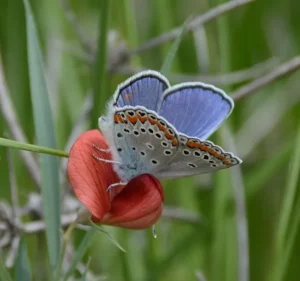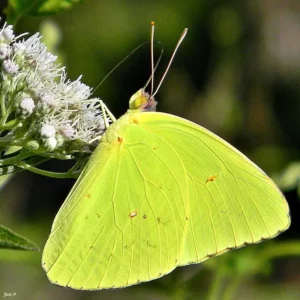Butterflies are one of the most beautiful insects. Let us discuss major examples and some facts around it.
A butterfly is a type of insect with broad, vibrant wings and a slim body. Butterflies are the insects that humans are most attracted to because of their vibrant colors and frequent visits to flowers.
- Cabbage White Butterfly
- The Lotis Blue Butterfly
- Queen Alexandra’s Birdwing
- Western Pygmy Blue Butterfly
- Red Admiral Butterfly
- Monarch Butterfly
- Painted Lady Butterfly
- Small Copper Butterfly
- Black Swallowtail Butterfly
- Brown Argus Butterfly
- Common Blue Butterfly
- Cloudless Sulphur Butterfly
- Small tortoiseshell Butterfly
- Marbled white Butterfly
- Green Veined White Butterfly
- Zebra Longwing Butterfly
- Ringlet Butterfly
- Essex Skipper Butterfly
- Common Wood nymph Butterfly
- Peacock Butterfly
- Morpho Butterfly
Cabbage White Butterfly
An extremely prevalent species of white butterfly found throughout Asia and Europe is the Cabbage White Butterfly. The body of a larva is velvety-green with a slender yellow dorsal stripe and a row of yellow dots running laterally down the body. Adults have a wingspan of about 45 mm and are white with several black patterns on the wings.
The Lotis Blue
A tiny butterfly, the Lotis Blue Butterfly only has a one-inch wingspan (2.5 cm). Majority of North America is home to these lovely blue butterflies. Because so many of their native peat lands are being burned by fires, these butterflies are in risk of extinction.

Queen Alexandra’s Birdwing
Queen Alexandra’s Birdwing is the biggest butterfly in the world. Over 11 inches is the size of their wingspan (30 cm). In comparison to a typical butterfly species, these butterflies are roughly ten times bigger.
Western Pygmy Blue Butterfly
The world’s smallest butterfly is the Western Pygmy Blue Butterfly. Their wingspan is 0.5 inches (1.3 cm). They are widespread across both North and South America. The body and inner wing surfaces of these small butterflies are slate blue. On the outside of the wing, there are white stripes and black rings that gradually fade into a brown color.
Red Admiral Butterfly
The size of the open wingspan of a Red Admiral Butterfly is between 4.5 – 7.6 cm. Their fore and hind wings have marginal bands made of bright orange to red colored stripes against a black background. Additionally, the forewings of these insects feature white stops near the tip. Red Admirals have local habitats that enable them to survive in different regions of the planet where they are found.
Monarch Butterfly
One of the butterfly species with the most distinctive appearances is the huge, brilliantly colored monarch butterfly . Their wingspan is between three to four inches, and they have two sets of wings. Their wings have white patches along the edges and a vivid orange color with black borders and veins.
Painted Lady Butterfly
One of the most prevalent butterfly species worldwide is the orange and black Painted Lady (Vanessa cardui). It cannot survive severe frosts or extremely cold temperatures because, unlike many butterflies, it does not go dormant throughout the winter. As a result, during the winter it moves to warmer climates.
Small Copper Butterfly
The Small Copper butterfly is as colorful and as small as its name suggests. The forewings of the little copper are bright orange with dark brown markings, and the border is thick and dark brown. It has hindwings that are dark brown with orange bands. Males are territorial and can be seen waiting for females by basking on exposed ground or rocks.
The Black Swallowtail Butterfly
A black swallowtail has wingspan measures up to three to four inches. Rows of yellow spots are scattered along the borders of its forewing and hindwings, which have dark blue to black uppersides. On its hindwings, it also exhibits a blue band of spots and eyespots that are orange-red. Its wings have two rows of orange dots on the undersides of their black surfaces.
Brown Argus Butterfly
The upper wings of the Brown Argus are bronzy-brown, and each wing’s edge is bordered by an orange band of dots. The adult butterflies have a silvery look. Although it tends to be smaller and lack any blue in its wings, it is extremely similar to the female Common Blue in appearance. As they fly close to the ground, so they often sit and feed on flowers.
Common Blue Butterfly
A little blue butterfly called the common blue flies from April to October during the summer. The vibrant blue, brown border, and white-fringed wings of the male common blue is stunning. The female has a blue “dusting” close to its body and is brown overall. In contrast to the similarly colored holly blue, it has orange markings on the underside of its hindwings.
Cloudless Sulphur Butterfly
The large yellow sulphur butterfly, also called the cloudless sulphur butterfly, is prevalent across most of the entire United States. Typically, the wingspan of sulphur butterflies is 2 to 3 inches. Normally, the females have a dark mark in the centre of each forewing, whereas the males are typically solid yellow.

The small tortoiseshell Butterfly
The little tortoiseshell butterfly is a medium-sized, attractive species that regularly visits gardens where it feeds buddleia and other flowers. Small tortoiseshell males are highly defensive and territorial in nature. The little tortoiseshell’s color is predominantly reddish-orange with black and yellow patterns on the forewings and a ring of blue spots around the edge of the wings.
Marbled White Butterfly
A unique medium sized white butterfly with black-chequered markings. The adults are frequently observed eating purple flowers including wild marjoram, common knapweed, and field scabious. Having a distinctive look, the Marbled White butterfly ranges in size from medium to large.
Green Veined White Butterfly
The common Green-veined white butterfly is a tiny, white butterfly that can be found in a range of settings. The forewing of the green-veined white has one or two black spots on it, along with black wingtips. It is smaller than the large white and has fewer black spots on its wings.
Zebra longwing Butterfly
The wings of the Zebra longwing butterfly are long and thin. It has black wings with pale yellow stripes that resemble zebras. Its antennae are long and black. Warm, humid tropical regions are home to the zebra longwing butterfly.

Ringlet Butterfly
The Ringlet butterfly has a white fringe running the length of its velvety wings. It is a dark, sooty to chocolate brown in color. Looking at the eyespots on their wings is the best way to recognize “brown” butterflies.
Essex skipper Butterfly
Essex skipper is a common butterfly that has a tiny body and a quick flight. The forewings of the bright orange-brown wings are held angled above the hind wings. Forewings of males have a thin, parallel-to-the-leading-edge black line running through the centre. The Small Skipper has longer scent brand that are inclined to the margin of the forewing but lacks black points on the antenna.
Common wood nymph butterfly
Adult Common wood nymphs are generally brown or greyish brown in hue. A row of eyespots are often present on the underside of the hindwing, however in certain individuals, these spots may be absent or fewer in number.
Peacock Butterfly
Peacock Butterfly has a single, big eyespot resembling a peacock feather is present on each of the brownish-red wings, which is used to frighten predators. The almost-black, well-camouflaged bottom is seen when its wings are closed while it is at rest. Among garden butterflies, it is one of the most prevalent.

Morpho Butterfly
A stunning butterfly with dazzling blue wings is called the Blue Morpho. They are one of the most well-known butterflies and a beloved species of rainforest because of their spectacular appearance and size.
Six legs and two sets of fore and hind wings are attached to the thorax. The eyes of Morphos are known to be extremely sensitive to UV radiation. This implies that male can see one another far away.
Conclusion
To sum up this post, we conclude that butterflies are important part of an ecosystem. They play various role in maintaining natural balance, one such is pollination. There are different varieties of butterfly found on every part of the earth except Antarctica. Many of the species have been extinct and many are in the endangered category.
Also Read:
- Polygenic traits examples
- Do prokaryotes have vacuoles
- Hypotonic vs isotonic
- Non capsulated bacteria
- Middle lamella function
- Trophic level
- Are bacteria photosynthetic
- Cell without cytoplasm
- Prokaryotic chromosome structure
- Foliose lichen

Hi, I am Saif Ali. I obtained my Master’s degree in Microbiology and have one year of research experience in water microbiology from National Institute of Hydrology, Roorkee. Antibiotic resistant microorganisms and soil bacteria, particularly PGPR, are my areas of interest and expertise. Currently, I’m focused on developing antibiotic alternatives. I’m always trying to discover new things from my surroundings. My goal is to provide readers with easy-to-understand microbiology articles.
If you have a bug, treat it with caution and avoid using antibiotics to combat SUPERBUGS.
Let’s connect via LinkedIn: